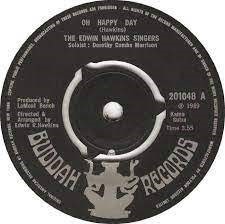
Edwin Hawkins
In 1968, the forty-six-member Church of God in Christ (COGIC) Northern California State Youth Choir, under the direction of Betty Watson and Edwin Hawkins, produced its first album, Let Us Go into the House of the Lord, a collection of eight traditional gospel songs rearranged by Hawkins. Conceived as a fundraising project and recorded in a church using only two microphones for choir, soloist, and instrumentalists, the album, which included "Oh Happy Day," sold six hundred copies mainly to a largely COGIC congregants. The 1969 video of this song documents the beginning of contemporary gospel.

The Edwin Hawkins Singers - Oh Happy Day 1969
"Oh Happy Day" is an excellent example of Kernodle's statement about the myriad musical influences on contemporary gospel music. Perhaps due to its popular music sound, approximately ten months after its original release, when "Oh Happy Day" inadvertently received airplay on an underground radio station in San Francisco, the record distributor had orders for 1,300 copies of the single the following morning. The tremendous popularity of "Oh Happy Day" prompted an ensuing scramble from major record companies, resulting in the group's subsequent signing with Buddah Records.
"Oh Happy Day" eventually received airplay in five different markets and achieved sales of one and a half million, defying the typical limitations imposed by genre and race. In the process, it ushered in the contemporary gospel music era-gospel music on the cutting edge, sonically consonant with the popular music of the day (Edwin 1969, 67).

"Oh Happy Day" 7" single on Buddah Records
Unlike the performers of traditional gospel music, who include soloists, small ensembles, and mass choirs, those performing contemporary gospel music are typically small ensembles. Contemporary gospel replaces the predictability of traditional gospel music and its easily memorized melodic lines and parallel motion in the vocal parts with more complex forms, syncopated rhythms, and harmonies. The instrumental accompaniment and vocal arrangements of contemporary gospel music are virtually indistinguishable from secular music counterparts. For instance, this video of "Oh Happy Day" uses bongos and congas and a Latin rhythm (a rhythm not typical for gospel music). The music listening guide on the next page outlines music characteristics and performance practices evidenced in the interplay between the soloist and choir.





